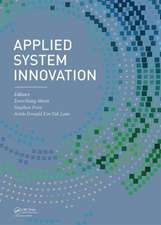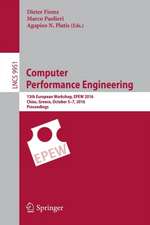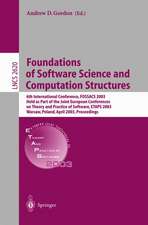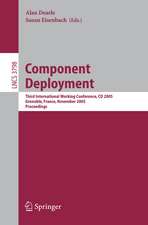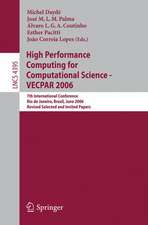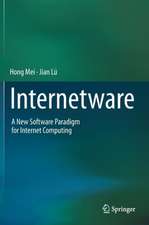Robust Model-Based Fault Diagnosis for Dynamic Systems: The International Series on Asian Studies in Computer and Information Science, cartea 3
Autor Jie Chen, R. J. Pattonen Limba Engleză Hardback – 31 dec 1998
| Toate formatele și edițiile | Preț | Express |
|---|---|---|
| Paperback (1) | 1819.90 lei 6-8 săpt. | |
| Springer Us – 2 noi 2012 | 1819.90 lei 6-8 săpt. | |
| Hardback (1) | 1827.48 lei 6-8 săpt. | |
| Springer Us – 31 dec 1998 | 1827.48 lei 6-8 săpt. |
Preț: 1827.48 lei
Preț vechi: 2228.64 lei
-18% Nou
Puncte Express: 2741
Preț estimativ în valută:
349.73€ • 379.76$ • 293.77£
349.73€ • 379.76$ • 293.77£
Carte tipărită la comandă
Livrare economică 22 aprilie-06 mai
Preluare comenzi: 021 569.72.76
Specificații
ISBN-13: 9780792384113
ISBN-10: 0792384113
Pagini: 356
Ilustrații: XIX, 356 p.
Dimensiuni: 155 x 235 x 25 mm
Greutate: 0.75 kg
Ediția:1999
Editura: Springer Us
Colecția Springer
Seria The International Series on Asian Studies in Computer and Information Science
Locul publicării:New York, NY, United States
ISBN-10: 0792384113
Pagini: 356
Ilustrații: XIX, 356 p.
Dimensiuni: 155 x 235 x 25 mm
Greutate: 0.75 kg
Ediția:1999
Editura: Springer Us
Colecția Springer
Seria The International Series on Asian Studies in Computer and Information Science
Locul publicării:New York, NY, United States
Public țintă
ResearchCuprins
1. Introduction.- 1.1 Background.- 1.2 Brief history of model-based fault diagnosis.- 1.3 Outline of the Book.- 2. Basic Principles of Model-Based FDI.- 2.1 Introduction.- 2.2 Model-based Fault Diagnosis Methods.- 2.3 On-line Fault Diagnosis.- 2.4 Modeling of Faulty Systems.- 2.5 A General Structure of Residual Generation in Model-based FDI.- 2.6 Fault Detectability.- 2.7 Fault Isolability.- 2.8 Residual Generation Techniques.- 2.9 Model-based FDI via Parameter Estimation.- 2.10 Fault Diagnosis for Stochastic Systems.- 2.11 Robust Residual Generation Problems.- 2.12 Adaptive Thresholds in Robust FDI.- 2.13 Applicability of Model-based FDI Methods.- 2.14 Integration of Fault Diagnosis Techniques.- 2.15 Summary.- 3. Robust Residual Generation Via Uios.- 3.1 Introduction.- 3.2 Theory and Design of Unknown Input Observers.- 3.3 Robust Fault Detection and Isolation Schemes based on UIOs.- 3.4 Robust Fault Detection Filters and Robust Directional Residuals.- 3.5 Filtering and Robust FDI of Uncertain Stochastic Systems.- 3.6 Summary.- 4. Robust FDI Via Eigenstructure Assignment.- 4.1 Introduction.- 4.2 Residual Generation and Responses.- 4.3 General Principle for Disturbance De-coupling Design.- 4.4 Disturbance De-coupling by Assigning Left Eigenvectors.- 4.5 Robust Design Via Parametric Eigenstructure Assignment.- 4.6 Disturbance De-coupling by Assigning Right Eigenvectors.- 4.7 Dead-Beat Design for Robust Residual Generation.- 4.8 Two Numerical Examples in Eigenstructure Assignment.- 4.9 Conclusion and Discussion.- 5. Disturbance Distribution Matrix Determination For FDI.- 5.1 Introduction.- 5.2 Direct Determination of Disturbance Distribution Matrix.- 5.3 Estimation of Disturbance and Disturbance Distribution Matrix.- 5.4 Optimal Distribution Matrix for Multiple Operating Points.- 5.5 Modeling and FDI for a Jet Engine System 153.- 5.6 Conclusion.- 6. Robust FDI Via Multi-Objective Optimization.- 6.1 Introduction.- 6.2 Residual Generation and Performance Indices.- 6.3 Parameterization In Observer Design.- 6.4 Multi-Objective Optimization and the Method of Inequalities.- 6.5 Optimization via Genetic Algorithms.- 6.6 Detection of Incipient Sensor Faults in Flight Control Systems.- 6.7 Conclusions.- 7. Robust Fdi Using Optimal Parity Relations.- 7.1 Introduction.- 7.2 Performance Indices for Optimal Parity Relation Design.- 7.3 Optimal Parity Relation Design via Multi-Objective Optimization.- 7.4 A Numerical Illustration Example.- 7.5 Discussion on Designing Optimal Parity Relations.- 7.6 Summary.- 8. Frequency Domain Design And H? Optimization For FDI.- 8.1 Introduction.- 8.2 Robust Fault Detection via Factorization Approach.- 8.3 Robust FDI Design via Standard H? Filtering Formulation.- 8.4 LMI Approach for Robust Residual Generation.- 8.5 Summary.- 9. Fault Diagnosis Of Non-Linear Dynamic Systems.- 9.1 Introduction.- 9.2 Linear and Non-linear Observer-based Approaches.- 9.3 Neural Networks in Fault Diagnosis of Non-linear Dynamic Systems.- 9.4 Fuzzy Observers for Non-linear Dynamic Systems Fault Diagnosis.- 9.5 A Neuro-Fuzzy Approach for Non-linear Systems FDI.- 9.6 Summary.- Appendices.- A- Terminology in Model-based Fault Diagnosis.- B- Inverted Pendulum Example.- C- Matrix Rank Decomposition.- D- Proof of Lemma 3.2.- E- Low Rank Matrix Approximation.- References.
Recenzii
`From a research monograph point of view, this book is certainly a welcome addition to several recently published books in this important field of fault-tolerant control systems. The reviewer would like to congratulate both authors for the excellent job presented in this book.'
Automatica 38:1089-1094 (2002)
Automatica 38:1089-1094 (2002)

















